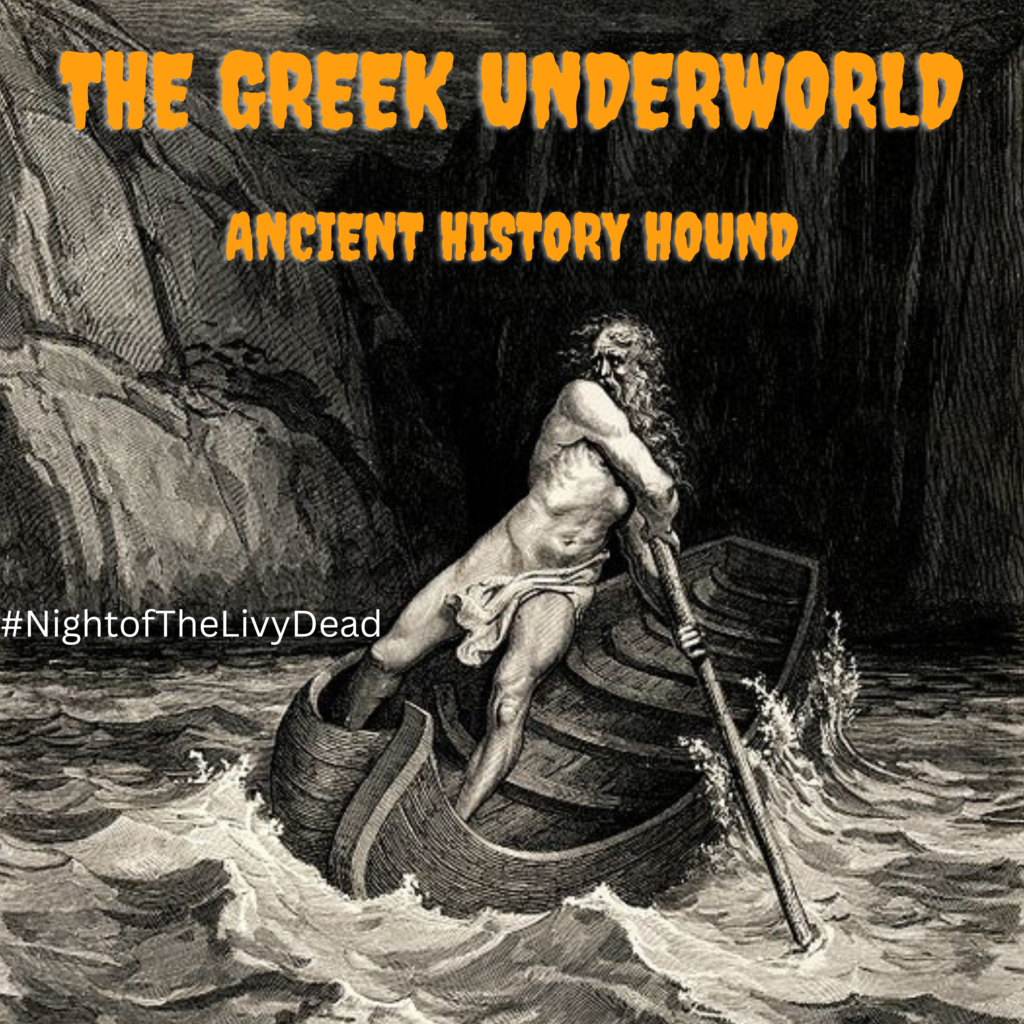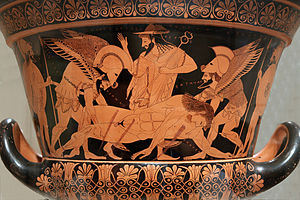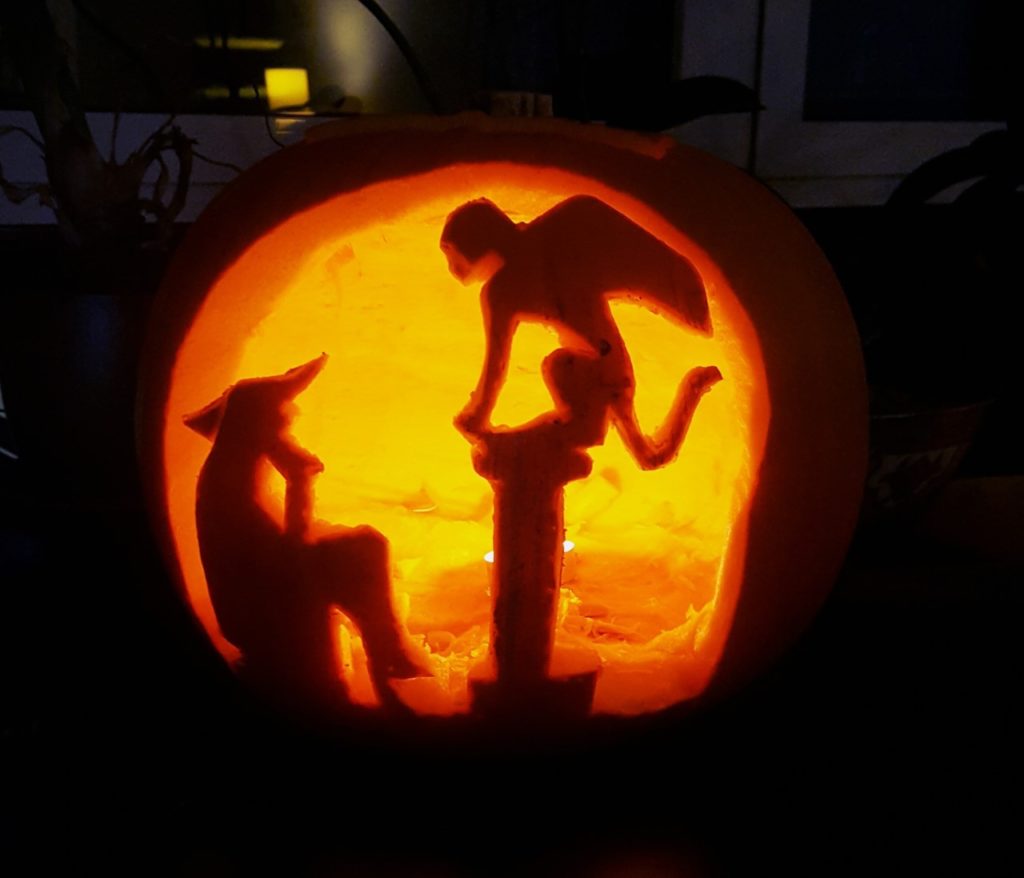The Underworld, Hades and a bit more content.
It’s Halloween and another in the #NightofTheLivyDead miniseries. I hope you enjoyed the episode, here are some notes and bits I mentioned.
Hermes and the drinking spirits.
I mentioned this is the episode towards the end.
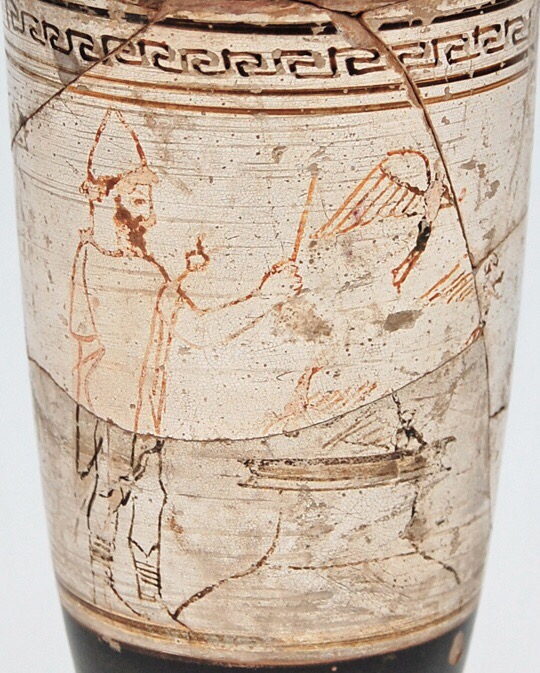
The lekythos (type of vase) with this image dates to 470 BC and attributed to the Tymbos Painter. Exactly what he’s doing is tricky to guess but you can see one spirit hovering above with another just at the top of the wine jar. We’ve all been there.
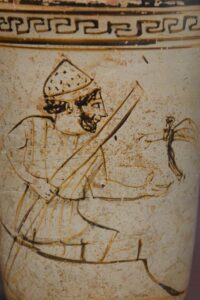
Vase images can be very helpful in adding to what we have, or don’t. This is Charon with a spirit and we can suppose that by this point Charon was a known figure and enough to feature on lekythoi (often used as funeral vases). He’s depicted as a normal person without the spirit you could mistake him for a regular mortal. Not the fearsome or dour character we sometimes see.
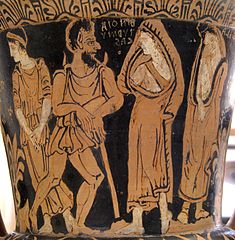
Charon, this time from an Etruscan vase (end of the 4th century BC). His features mark him out as well as the hammer upon which he leans.
Reading list / sources used.
www.theoi.com an incredibly good website for all mythology.
Aristophanes, Frogs
Euripides, Alcestis, Heracles
Homer, Iliad & Odyssey
Plato, Gorgias & Phaedo.
Ekroth, G. Hades, Homer and the Hittites.
Floky, A. Mythical and ritual katabasis in Aristophanes’ Frogs
Forde, S. The Comic Poet, The City, and The Gods: Dionysus’ Katabasis in the Frogs of Aristophanes.
Krauskopf, I. The religion of the Etruscans. In Grave and beyond in Etruscan religion
Mackin Roberts, E. Underworld Gods in Ancient Greek Religion.
Mikellidou, K. Euripides’ Heracles: The katabasis-motif revisited
Santamaria Alvarez. M.A The Parody of the Katabasis motif in Aristophanes’ Frogs.
Walter-Karydi, E. Polygnotos Nekyia or the Athenians and the Underworld.
Wheatcroft, A. On the Topography of the Greek Underworld and the ‘Orphic’ Gold Tablets
Transcription.
(there may be some minor changes)
Drunk spirits, Frogs and nudity. It’s a night of the Livy dead episode all about the Greek underworld on the Ancient History Hound podcast.
Hi and welcome to the Ancient History Hound podcast, for long time listeners Halloween means another instalment of the Night of the Livy Dead series. Over the years I’ve talked about werewolves, vampires, demons, ghosts and exorcisms in ancient Greece, Rome and even Mesopotamia. This year I thought it’s the turn of the Greek Underworld. In this episode I’ll be trying to unravel how the Underworld was described and perhaps envisioned in the Archaic and Classical Periods in ancient Greece. Central to this was the journey there, something called the katabasis. The ancient Greeks didn’t shape their understanding and expectation of the Underworld in isolation, so I’ll also bring in a couple of other myths and descriptions from cultures which predated the Greek accounts. As you’ll hear there are some interesting similarities and parallels.
As ever you can find me on twitter @houndancient for the podcast and @ancientblogger for myself. Episode notes with a transcription shall go on ancientblogger.com along with the sources I’ve used and I would doubly recommend you visit if nothing else to check out my pumpkins. That isn’t a euphemism by the way – for several years I’ve been carving Greek vase pumpkins and even a couple of Roman mosaics. I daresay I’ll stick them on twitter and also my Instagram as well – you guessed it where I am ancientblogger. And why the heck not, on TikTok where I’m ancientblogger. Yep, old dogs can learn new tricks it seems.
When the topic is the Underworld and you’re talking about the ancient Greeks there is one account which is always referenced. In Homer’s poem the Odyssey the hero Odysseus is tasked to visit the Underworld. As you’ll hear this is no mean feat.
It starts when Odysseus appeals to Circe to let him leave. Both he and his men have decamped on her island for some time but now Odysseus wants to move on and get back home. Circe hears his request and agrees but she adds a detour to Odysseus’ plans, and I quote “you have to make another journey and find your way to the Halls of Hades and dread Persephone to consult the spirit of Teiresias the blind Theban prophet”.
Odysseus is terrified by this proposition; he weeps for some time and confesses that he has no further use for life. It’s only a few lines but the sense you have is abject desperation. This is important because, pun intended, it’s a grave situation he’s in. This isn’t a journey anyone wants to make and in an epic poem where challenges and tests are aplenty this is one of the most severe.
When he recovers, he asks Circe exactly how this can be achieved and the goddess explains it all, firstly there’s a journey to undertake and then a complex ritual to perform. This itself is worth noting, the fact that Odysseus, a character known for his wisdom, is in the dark on this suggests that what follows is both secret knowledge and / or a ritual not know to the Greeks. It wasn’t something within the Greek cultural understanding. Again, that’s just a suggestion but it does link in with something about the ritual I get to later in the episode.
Odysseus follows Circe’s advice; he boards his ship and sails to a distant shore. Upon arriving he travels inland to a pinnacle of rock described by Circe.
Once there Odysseus performs a ritual known as a nekyia, this was done so he can communicate with the dead, it’s how he’ll get to question Teiresias but as you’ll hear it leads to much more than that. This started with the digging of a trench, the width and length of a man’s forearm. Into this Odysseus poured honey, milk and sprinkled barley. Next an invocation to the dead.
Then came the sacrifices, in this case black sheep who had their throats cut over the trench so the blood could pour into it. At this point there seems to be a sense of danger as the spirits of the dead appeared and made for the blood. Odysseus keeps them at bay with his sword in hand whilst his colleagues performed a separate sacrifice to Persephone and Hades.
There seems to be two functions operating in tandem, the nekyia to communicate with the dead and sacrifices and invocations to the dead and the deities to ensure that Odysseus and his men are kept safe.
When Teiresias appears, Odysseus allows him to drink the blood and the two converse. Odysseus now has the information he needs to carry on. However, this isn’t it, rather than embarking on the next stage of his journey Odysseus embarks on a spree of networking with the famous and infamous amongst the dead. In fact, prior to speaking with Teiresias he even chatted with his mother, it’s a poignant scene as he attempted to embrace her in vain but instead grasped empty air.
Much of Odysseus’ discussions with the dead involves the linking in with other myths and it’s fascinating purely from this standpoint. However, for the purposes of this episode the chat he has with Achilles gives us an interesting perspective on the Underworld.
Achilles bemoans his lot in the Underworld, he comments that he’d rather be a lowly farm worker in the world of the living than King of the Dead. This is quite something – in the Iliad he famously makes the decision to kill Hector, an act which he knows will bring about his death. A talking horse even reminds him of this. It’s the choice between a short and glorious life and a longer but less glorious one. Having made his choice Achilles seems to be displaying buyer’s remorse.
Finally, Odysseus’ encounter with the dead offers some literal insight, he sees a lot. Not just mythological characters but what they are doing. There’s Tantalus and Sisyphus receiving their respective punishments and even King Minos acting as a judge. As you’ll hear the concept of judgement was an important one in the Underworld.
Though it’s not given a five-star rating the Underworld wasn’t entirely unpleasant, at least not in this account. Odysseus sees the pleasant meadow of Asphodel, which by its own description seems a nice place to end up. Earlier in the Odyssey Menelaus was told that when he died, he’d end up in the Elysian Fields. Very nice indeed but it isn’t clear from Homer if these were located in the Underworld specifically.
Another poet of the Archaic period, Hesiod, also described the Underworld with some additional information. In the Underworld you’d find the great pit of Tartarus which held the titans who had rebelled against the Olympians, it was where the homes of Night, Thanatos and Hypnos were found. Hades and Persephone also had their halls here which were guarded by Cerebus. None of this is couched in pleasant terms, it’s gloomy, dark and even the characters are described as awful or terrible. And yet there is a silver lining, the Islands of the Blessed for example, which are reserved for heroes and those who qualified for a better existence.
Both Hesiod and Homer give us a general description of the Underworld with which we can form a basic overview. It’s not a single place but one with separate areas or regions. There’s also the concept of judgement linking in to where you might end up. That said when Menelaus is told he’ll be afforded the Elysian Fields it’s done with the rationale that this is because he’s married Helen and so a son-in-law of Zeus. In this case it’s not what you’ve done, but who you knew.
The accounts give us some familiar names such as Hades and Persephone. Cerberus, everyone’s favourite hell hound is given a mention but only named by Hesiod. When Homer mentions him, he’s referred to as the Hound of Hades. Hesiod described him as having 50 heads, and in antiquity the three headed Cerberus was just one option.
We also heard from Hesiod how he was a big softy if you were going through the gates of the Underworld. Try to go back through the gates and you’d witness his other more terrifying side. This aspect underlines how the journey to the Underworld was a one-way affair and I’ll pick up on that later.
Minos is spied by Odysseus acting as a judge, but another judge is named, Rhadamanthus. Both these were sons of Zeus and noted for their wisdom. Another judge is mentioned in the Classical period which I’ll get to. And from judgement we get the segregation of the Underworld, the pit of Tartarus, meadows of Asphodel and Elysian Fields. Perhaps, as with Menelaus, not all areas were possibly for your average deceased, but you might end up somewhere not entirely unpleasant.
Homer and Hesiod also mention that famous Underworld feature, the river Styx. In fact water plays an important role in the Underworld. It was often a feature to be crossed, whether it was the large sea that Odysseus initially had to navigate, the Styx or other rivers such as Acheron which are mentioned.
Given the importance of water and the presence of the Styx the absence of Charon, the ferryman of the dead is a surprise. Neither Homer or Hesiod refer to him in any way, but one other archaic poem did feature him. This is the Minyas, thought to have been composed in the 6th century BC and so later than Homer and Hesiod. We don’t have the poem, but we know of it and the inclusion of Charon from a reference to him which the later Greek writer Pausanias made. Perhaps Charon was a figure yet to be fully ensconced in the Greek Underworld. He certainly became a popular figure, not just in Greece. In later Etruscan art Charon or Charun, spelt with a U, is depicted on tomb walls sometimes with blue skin and a hammer. He still kept a similar role as someone connected with the dead, but not so much as ferryman.
There was another character associated with the dead who is mentioned later in the Odyssey and not only makes a journey to the Underworld but leads a group of spirits there. One of the manifestations of Hermes was Hermes Psychopompos, the conductor or guide of the dead. It might seem odd but Hermes was a god associated with liminality, that is to say the in-between places. In this case between the world of the living and the dead. Much of the Odyssey ends when Odysseus visits his revenge on the suitors but there’s much more to the story. I won’t get into it here but let’s just say that Odysseus behaves in an increasingly erratic manner once he’s back at Ithaca.
In any case, back to Hermes. After Odysseus has avenged himself and slain the suitors Hermes appeared and summoned their spirits. they follow him squeaking like bats, which is a wonderful but curious description, and arrive in the Underworld specifically at the meadow of Asphodel.
Here the suitors witness and engage in conversation. They hear Achilles and Agamemnon the latter even pausing to speak to one of them.
The spirit of one of the suitors, Amphimedon informs Agamemnon how they ended up in the Underworld, even justifying to an extent Odysseus’ revenge. But he also makes comment which is worth considering. He describes how their bodies are still lying in the palace unmourned. This might seem insignificant, merely Amphimedon adding to the tragedy of it all and neatly giving a timescale to his interaction. But there may be a problem here. You see, in Greek culture few things were more important than burial rites. Indeed, in the Iliad the spirit of Patroclus even appeared to Achilles to ask him to get a move on.
The reason? Well, as the spirit of Patroclus pointed out to Achilles, without the correct burial rites his spirit cannot fully enter the Underworld. But here we have the suitors in exactly that place or seeming to be. Perhaps, the meadow of Asphodel was a sort of waiting room or had that facility.
Perhaps though there’s a simple answer in that I’m looking for something which isn’t there. The Odyssey and Iliad weren’t theological texts outlining the religious framework of their day. They absolutely reference the central values which we might categorise as religious in the modern sense, but they were primarily poems. The intention was to tell a story, to entertain and not deal with eschatological technicalities. Perhaps the contradiction results from this, the change because each worked better in the story. In the case of the suitors we have Odysseus’ revenge being discussed and not criticised, giving it validation. It’s also a nice contrast as one of the responses is from Agamemnon a character killed once he also returned home. Actually, in the Odyssey it’s all he pretty much goes on about. As for Patroclus complaining about his lack of full burial, well, it gives the character of Achilles more range. He’s so broken by the death of Patroclus that he simply can’t let go.
The overarching lesson here is that different poems and poets seemed to have dealt with the Underworld in a more thematical sense than anything else. In a way this makes sense, in the modern age we are far more attuned to mapping everything out and aligning every detail, even retrospectively. Just listen for the internet howls if someone makes a film in a franchise and it doesn’t all line up perfectly.
So then, to the comic stage and the Underworld.
In 405 BC the Athenian comic playwright Aristophanes wrote the Frogs, it’s a brilliant play in which the god Dionysus embarks on a katabasis. The rationale for this is to bring up a deceased poet as he’s fed up with the current dearth of talent. The comic techniques used included farce, visual gags, in-jokes and what you might expect but at the heart it’s a parody of the katabasis and that’s why it’s such an important source in this context. I’ll get to the parody element later but first here’s a brief overview of the play and how the Underworld is presented.
To begin with the character of Dionysus has relevance in the Underworld, there’s even a myth where he had his own katabasis in order to fetch back his mortal mother. But as often with the Greek pantheon a deity has associations in areas you might not suspect, and Dionysus was one of those deities who had links with the Underworld.
The katabasis in the play contains elements we might be familiar with but also gives artistic licence to a character who hasn’t yet featured in the surviving works. When Dionysus and his mortal slave arrive in the Underworld and reach a marsh the figure of Charon appears. There’s a suggestion that in the play he’d have appeared on a boat with wheels and when reading Greek comedy, it’s easy to forget just how much humour resided in the visual and physical gags. It’s in this play that the reference to the fee of two obols to cross on Charon’s ferry is made. This is where we get it from.
As he journeys across the marsh with Charon Dionysus gets into an argument with some signing frogs, hence the title of the play. It’s plausible that the chorus would have dressed as frogs whilst they danced and sang.
It’s not all cheery though, on the other side of the marsh the landscape shifts into darkness and shadows. Here Dionysus and his slave encounter an Empousa. This was a monster which could change form and had one leg of brass, that’s not a comic thing it’s apparently a genuine feature. What’s notable here is that that the Empousa wasn’t tied to the Greek Underworld, like many monsters of Greek myth it featured above ground.
The final element of the Frogs I want to mention is what the pair encountered next. Initiates. These are a group of individuals singing, dancing, and playing music. They mention that they are on their way to the meadow and we assume that here’s a reference to the meadow of Asphodel. At the very least it carries on that theme touched upon, that the Underworld is formed of different areas.
The initiates linked into a substantial cultural and religious phenomena in the world of the living. Near to Athens sat the sanctuary of Demeter at Eleusis and it was here that an annual procession was made which concluded in a series of rites known as the Eleusinian Mysteries. Exactly what the concluding rites were we don’t know, it was fundamental that any initiate kept them a secret but here we have something which many of the audience watching this play may have been a part of. In previous references to the Underworld we had a sense that the life you lived affected your afterlife and this is extended into the area of worship. Undertake these rites, become an initiate and you might be rewarded.
What runs through the Frogs is the journey, the katabasis and it’s this which is parodied. Elements such as the brave hero, the wise guide and judgement are either inverted or given the comic treatment. Of course parodies only work if you use a commonly accepted thing to parody. In short if they were able to sit in an audience and laugh at a paraody of a katabasis they were probably quite familiar with what one was. And it turns out that this is true because though the parody here survives we know of other comedies which don’t survive and also used the katabasis as a setup.
For example, Eupolis’ play Demoi or the Demes involved a reverse katabasis wherein five famous names from Greek history, such as Solon were chosen to travel to Athens. A more conventional katabasis, if you can call it that featured in Pherecrates’ play The Miners. In this case a woman describes the Underworld after her visit as a place of luxury and abundance. There was even a lost drama written by Euripides named after someone I’ll be mentioning shortly which had the katabasis as a central plot.
The katabasis was something kept in the Greek imagination as it was a backdrop for a couple of myths.
I’ll start with Heracles, one of his labours involved going to the Underworld and bringing back cerberus. This is a myth referenced in both Homer’s Iliad and Odyssey and it comes with the caveat that in each the name Cerberus is absent, as I mentioned earlier, it was Hesiod who named him specifically. This feat can be seen as a trial of strength and to an extent determination. But I prefer to consider it more in the context of bravery. Cerberus or the Hound of Hades is normally described in the context of being fearsome, and I think this is the real test here. Both the journey down to the Underworld and the idea of dognapping was a test of Heracles’ bravery in the way that the other Labours weren’t, at least to the extreme here.
This can also be seen in part through the parody of this virtue in the Frogs. Here the character of Dionysus is the opposite. He’s played as a character more akin to Shaggy from Scooby Doo than any real hero.
The katabasis of Heracles in his labour is one of overcoming a test. But what when it went wrong? In the case of Pirithous this is what happened. Pirithous was a mythical figure, a friend of Theseus, who decided that he wanted Persephone. Therefore his katabasis was an abduction, but this time to take Persephone out of the Underworld and he’s joined in this by his friend Theseus.
But the two come unstuck, or rather they are unable to. When the pair sit on a couple of stone seats they cannot get back up. Theseus is rescued by Heracles. As for Pirithous, well, he stayed on the chair. This myth formed the story of that lost play by Euripides I mentioned moments earlier. We don’t have a great deal of detail on it but one tantalising argument is that Pirithous was further punished by being fed to Cerberus.
Finally, here was Orpheus. This is possibly one of the most famous myths from antiquity. Orpheus loses his wife. Eurydice, to a snakebite and descended to the Underworld. There he showcases his skills as a musician to such an extent that he is permitted to leave with her on the condition that on the journey back he doesn’t turn round to look at her. Unfortunately he does and as a result she is lost to him forever.
On a side note this myth is a great example of how we can fall into a trap of thinking of myths as one coherent thing. Let me explain. Neither Homer or Hesiod mention Orpheus or this myth, in fact it’s not till the 5th century when the myth is referenced at all in literature and even then it’s just that a reference. The first time Orpheus’ wife is named isn’t till a poem in the 1st century BC and the myth as you would have heard it was fully laid out not by a Greek, but by a Roman poet called Virgil.
It seems then that the Greeks of the Classical Period were aware of the myth but we don’t have a great deal of comment about it until much later.
Sat alongside these Odysseus’ katabasis seems lacking. By its own definition the word means something like to travel down and Odysseus doesn’t exactly do that. He certainly journeys, but this is more to a liminal place where he then conducts that ritual which is actually how he draws the dead to him. We don’t have that same sense of a distinct journey into the Underworld and interacting with what’s there. This has led to some debate as to whether it qualifies as a katabasis in the true sense or at least in the ways that the others did.
Given the nature of cultural exchange in the Mediterranean it won’t surprise you that the notion of the katabasis wasn’t unique to the Greeks.
In Mesopotamia there was the descent of Inanna which was recorded on a poem. This dated to the early 2nd millennium BC, so at least 1,000 years prior to the Iliad and Odyssey. Despite the distance in time and geography there are elements of it which seem familiar.
Inanna was a Sumerian goddess and she journeyed to visit her sister, the fantastically named Ereshkigal, Queen of the dead. Even as a goddess her trip wasn’t easy, she was greeted at the gates of the Underworld and proceeded through seven of them and at each she gave an item of her clothing. When she arrived to meet her sister she was judged and turned into a corpse. But Innana wasn’t naïve and had ensured that in such an event her faithful servant would send two demons down to revive her with the water and food of life.
But even then Inanna couldn’t just return and was required to have a substitute to take her place and the choice was her husband, Dumuzi. This might sound unusual except Dumuzi didn’t conduct himself too well when news got out that Inanna had been kept hostage, he’d actually celebrated. But even he had insurance in the form of Geshtinanna, his sister and the two rotated their commitment to the underworld, each spending 6 months there.
An underlying theme to this myth was the separation of the Underworld from that of the living. There are those gates, the fact that even a goddess wasn’t safe to make the journey and the need for balance, that is to say you don’t leave without someone replacing you. This was further underlined in sinister tones by a later version of the myth, written in the period 900-600 BC. At one of the gates Inanna becomes frustrated by being kept waiting and threatens to tear the gates down and raise up the dead who will eat the living.
Finally, there’s Nergal and Ereshkigal. Like the descent of Inanna or Ishtar there is an earlier myth dating to around the 15th century BC and a later on in the 7th century BC. In this Nergal seeks to conquer Ereshkigal and become the King of the Underworld. This task is a challenge in itself but also contains the theme of tests, something we’ve heard of in the myths I’ve already spoken about. In this instance it’s something which sounds familiar, the avoidance of eating or drinking anything in the Underworld. Perhaps this wasn’t that difficult, the food is described as akin to dust and the beer as muddy water. Though there are lines missing in this poem we know that the two rule together eventually but only after a struggle. There are some similarities here with the myth concerning Persephone and Hades. This too involved a physical struggle, the pursuit of marriage and food as a possible trap.
This isn’t the only time that a link or parallel with cultures outside of Greece can be noted. I started this episode with Odysseus and I’m going to focus on that rite he performed. This was to contact the dead and such a rite was known as a nekyia. What’s of particular interest was that trench which was dug and combined with the offerings within it attracted the spirits of the dead.
Pit rituals, including those which were made to consult the future and spirits of the dead was a practice the Hittites took seriously. The Hittites were a people based in the centre of modern day Turkey and who had their heyday in the mid to late 2nd millenium BC. This practice may have spread elsewhere, in the 8th century BC a tablet detailed a story involving Gilgamesh. Here a pit featured as a way he communicated with his deceased friend Enkidu.
Both the Iliad and Odyssey have been sifted for instances which may reflect older customs which may have been not fully realised that the time. For example, the sacrifice of the Trojan youths by Achilles at the Funeral of Patroclus. This was certainly not contemporary Greek custom but pointed to an earlier practice which had been abandoned by the time of Homer. It’s possible the pit ritual was once practiced by the Greeks or is just being referenced as something which was once done by another people.
It just goes to show how important these poems were in housing what were at the time of composition older and perhaps almost forgotten practices.
Moving back to Classical Greece Plato proposed a mini-chronology relating to an aspect of the Underworld which I’ve mentioned, judgement. Just to recap what we’ve previously had is two main names involved as judges, Minos and his brother Rhadamanthus. In his play The Frogs Aristophanes featured a third, Aecus. In his work Giorgias Plato outlines how the three worked and also how they came to be employed as judges in the first place.
According to Plato their had been an existing process of judgement in which judgement was handed down to humans on their last day of life. However, Hades pointed out that this system had a flaw, that the judges were easily duped by the appearance of those they were judging. That the soul of the person wasn’t as easy to assess. It might also be that those judged were able to prepare for their judgement in some way. The implication is that proper judgement wasn’t an outcome.
The solution was to remove two aspects. The first of any notification or your death so you were judged after you had die. The second of any clothing and this included the judges. Presumably this prevented anyone gaining an advantage from their appearance and Plato underlines that this allowed the soul to be examined more clearly. The judgement was done in the first instance by Aecus and Rhadamanthus with Minos as a sort of supervisor.
Plato featured the dead and the afterlife in a number of his works, the notable in this context being the Phaedo, Gorgias and The Republic. As you might expect this got very technical at points and though I have avoided the topic of the soul it’s in the Classical period where the concept of the soul is more heavily investigated and considered. For Plato the issue of judgement and what happened to the soul wasn’t boiled down to simply a good or bad outcome. He adds a layer of beaurocracy. A soul may have led an ok life or committed minor crimes, in which case they were required to go through a purification process in the case of the former or face temporary punishment in the case of the latter. The truly egregious go straight to Tartarus and likewise those who have lived incredibly well go immediately to the nicer places.
Added to the eschatological was the geographical, Plato describes a complex layout of streams and rivers such as the acheron and styx. This included the Lethe, where the dead would drink and thus forget their previous life. Both Homer and Hesiod described the network of rivers and this goes back to the point I mentioned earlier as to how water was important. Perhaps here its because it was a boundary, these rivers marked out sections of the Underworld and I suppose carried over this function from the land of the living.
And on that point it’s important to veer away from the idea that the Underworld was a sub-terranean place. The descriptions we have from Plato and the other sources is that it was a place within itself with meadows, rivers and regions. Tartarus seems to have been a lower part within it and the nicer locations such the the Elysian Fields and Islands of the Blessed described in glowing terms. Curiously Pindar described the Islands of the Blessed in a victory ode dated to 476 BC and commented on the playful winds there. Though you might have travelled down to it the Underworld was a space within itself.
In direct contrast to the serious nature of the soul and the far away Underworld was a festival I want to finish on. One of the reasons I love the subject of ancient history is that you can have Plato and the drier discussions but also find the slightly bizarre and more fun.
In spring the Athenians celebrated the Anthesteria, this was a three day festival in honour of Dionysus. Primarily it was focused on the stored wine which was opened and drunk. Each day had it’s own name, the first day was the ‘jar-opening’, the second ‘the pouring’ and the third was called ‘the pots’. You can probably guess what went on from the names of the frist and second day. The third though was named ‘Chytroi’ ,the pots, after the small pots of food left out not for humans, but for spirits of the dead and as an offering to Hermes. The expecation was that the dead were allowed to join in with the festivities and on the last day the focus was on Hermes guiding them back to the Underworld. One of my favourite vase images is found on a lekythos a type of small vase often found in or around graves. On this Hermes is shown with his wand and seemingly gesturing at some small figures which are suggested as spirits. Central to the action, and below the flying spirits are the large jars of wine. Perhaps Hermes is asking the spirits to form an orderly queue, or perhaps he’s indicating that they’ve had enough and it’s time to move on.
Sadly the important question of whether spirits get hangovers doesn’t seem to have been covered. One for Plato perhaps?
And on that note I hope you enjoyed another NightofTheLivy Dead offering, one day I’ll get it trending, and more importantly I hope you have a great time doing whatever you are doing for Halloween.
Till next time keep safe and stay well.

